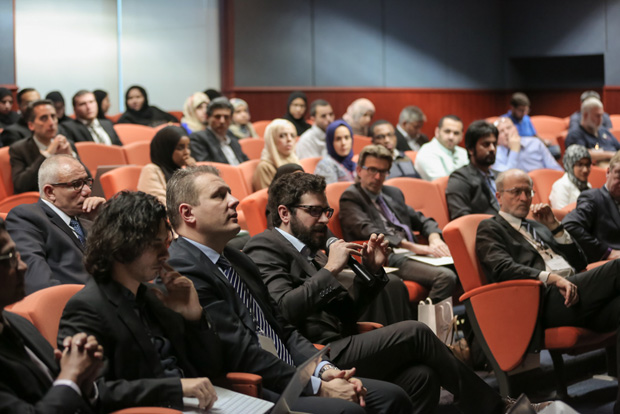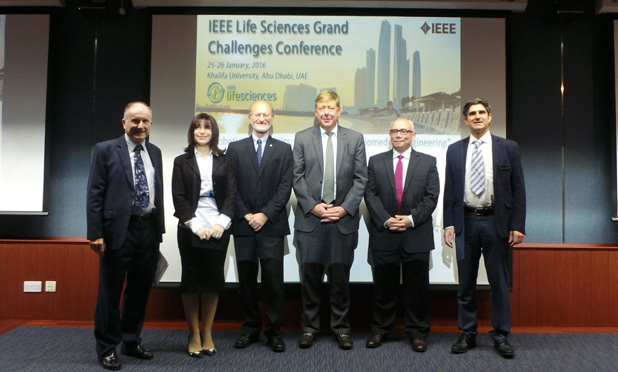Above: Panelists and moderators at the IEEE Life Sciences Grand Challenge Conference held in Abu Dhabi in early 2016.
The United Arab Emirates is dealing with many of the same healthcare challenges faced in other regions of the world, including problems with injury, obesity and diabetes. These and other issues were discussed in a special panel session entitled “Tackling Healthcare Challenges in the United Arab Emirates” held during the IEEE Life Sciences Grand Challenge Conference in Abu Dhabi in early 2016. In this panel discussion, representatives from academia, the private sector, the investment community, and the government shared with the audience their views on various challenges facing the healthcare sector in the UAE and other Gulf Cooperation Council countries and how research and development efforts can help address many of these challenges.
Participants included Dr. Ali Al Obaidli of the Abu Dhabi Health Services Company, SEHA; Dr Ahmed Morsy of Cairo University; Dr Martina McGloughlin of the Abu Dhabi Education Council (ADEC); Dr Yehya Almarzooqi of TAWAZUN Holding; and Dr. Paolo Dario of Khalifa University. Presiding over the event were moderators Dr. Tim McGloughlin, Chair of the Biomedical Engineering Department at Khalifa University and Dr. Hasan Al-Nashash of the American University of Sharjah.
Al-Nashash: What is the relationship between the private and government sectors in tackling healthcare challenges in the UAE?
Al Obaidli: Abu Dhabi Health Services Company is the operational arm of the government of Abu Dhabi. We manage 12 hospitals, 62 ambulance centers, a total of nearly 3000 doctors and 17,000 employees. I think the whole vision and mission of SEHA is to deliver care and health services at international standards. We see ourselves playing a role to help healthcare systems to develop and mature to fulfill the government’s vision and mission. So we have many of the pilot projects that the health authority as a regulator plans to introduce into the sector. We have a single electronic health record system for the entire health system where our health system sees nearly 5 million patients or visits and more than 100 inpatient admissions. So now it’s fully functional and we see our role in trying to give the patient an integrated approach to healthcare so that if a person is from Al Ain, they can get treated but if they are referred to Abu Dhabi they don’t have to repeat all of their investigations again. We also work with the private sector and we see our role as complementary because health insurance was introduced as a mechanism of healthcare financing. The distinction between public and private sectors is gradually moving away because the ultimate supporter for the entire health sector is the government because they have put significant resources in financial support to establish the health insurance particularly the national health insurance. So this is some aspect of how we work where we look towards collaborating with the private sector but I think we need to go a step further and establish communications in collaborations with academic centers such as Khalifa University, nursing colleges and medical colleges industry.
Tim McGloughlin: What are the healthcare challenges in the Middle East?
Morsy: Major healthcare issues are related to habits and to certain aspects of the environment, and are related to certain aspects of economics and so on. So when you look at habits throughout the Middle East I think overeating, under exercising, smoking, and reckless driving, are very clear. You can observe them anywhere you go in the Middle East. What does that translate to? Obesity, high blood pressure, diabetes, cardiovascular diseases, and other diseases related to rehabilitation. Related to the environment, it’s very clear that the pollution level in cities in the Middle East is really high which causes a lot of problems as well. Cancer, in my opinion, is related to all the chemicals that exist now in the food and the pollutants in the air. So in my opinion, these are the major challenges when it comes to healthcare.

Al-Nashash: What is the status of funding biomedical research?
Martina McGloughlin: Last year we decided that when we couldn’t initially get sufficient funding to actually set up a research funding agency which was to be modeled on Science Foundation Ireland, we would do a pilot study to show that there is a pent up need for funding competitive research. We managed to collect not a lot of money but enough towards the end of the year to hold our competition called ADEC Award for Research Excellence. We have several excellent applications from across the whole of Abu Dhabi especially from Khalifa University. We got 250 proposals. These went out to international reviewers who said the quality of the research that has been submitted is amazing, and this type of research has to be encouraged because clearly this is going to be based on the future of economic diversity of this country after oil eventually does disappear. In fact, one of the areas that got the highest grades was the proposals that came from biomedical research. We saw that there is some incredibly interesting work going on here. And, of course, as previously mentioned, there are some very specific problems here that are not unique to the region but that definitely have a high incidence, such as, for example, diabetes and vitamin D deficiency. From these really good proposals one or two were funded in this area. Now that we have shown this proof of principle and the great response, we are now going forward to try to convince the government that it is absolutely imperative going if they want to help with diversifying the economy, and if they want to help with growing the human capital to have highly skilled and highly competitive Emirati population, that they have to invest into this phase.
Tim McGloughlin: What are the adopted mechanisms used to stimulate, protect and grow biomedical innovations?
Almarzooqi: I come from Tawazun, a bit about it is that our mandate is to stimulate the economy away from oil and gas into manufacturing. That obviously necessitates that we work hand in hand with government and academia. While the journey has not been easy, I must admit that in a country where the population of indigenous people are less than a million we are having difficulty enticing the younger generation to study science, engineering, and math. However, they are collaborating and bringing the best practices from Boeing business partners, Airbus, GE and other companies. There have been many cycles working in these fields in order to create a healthy lifestyle for academia as well. We also fully acknowledge and fully understand that we don’t want to get into manufacturing because it is labor intensive and we simply do not have the numbers, so we leave it to China and India as they do far better than we do. So what is our future? What is our vision? Knowledge based economy. How do we create that system? With the government and the private sectors and industry and academia working together. Fortunately, in the last 3 or 4 years that I have been associated with this, every one of us, including industry which is where I come from, operate side by side. There is also the need for academia to collaborate together. I think recognizing that we have an issue does provide 50% of the solution and I think the arrows are pointing in the right direction.
Now how do we take youngsters who have the bright idea, and encourage them to translate some of these ideas into product? We are reaching out to all the Arab youth, not just the UAE youth, and our expat colleagues in the country. We have signed MOUs (memorandums of understanding) with Khalifa University, with the Khalifa Fund, Tawazun and Mubadala. We are creating an incubator which will be operational by April 2016 and we are calling it a Business Accelerator. If somebody has an idea, they come to us, they present it to the panel and could get initial funding of 300,000 AED to take it to the next level. If this product needs to be prioritized we give it one million and the funding is already there. We provide an office for the individual, he doesn’t need to have a license to operate. There will be a mentor and coach from that sector. We will allocate people from finance and to refine the product and take it to the world.
What is happening here is that sometimes they will come up with an idea in terms of biomedical science but unfortunately there is no collaboration between engineering departments and various faculty and the biomedical department, so it is that isolation that we are trying to break. One of the ideas that we will put forward at Tawazun is that we will give the contract to one of the leading universities but we will dictate that by design they will have to collaborate together, where there are specific percentages that need to be spent with other entities such as Masdar and universities. So hopefully down the road, that barrier will be broken down and we will see the youth running the SMEs which are the backbone of the economy of any country.
Al-Nashash: What is the experience of other nations in managing collaborations between industry and academia?
Dario: Just two points: there is a lack of ambition here and that should not be the case. Giving more money to researchers is probably good for the early phase. But then what I strongly recommend is that we move into larger ambitious projects with 3-4 million dollars each. There are so many examples that when you inject large amounts of money, it can, in addition to achieving respectable results, create momentum and critical mass to educate and create another project. The second point is collaboration. Again, this is quite unique to Europe. In order to compete, you must collaborate. There is, of course, the European Research Council that supports individual projects but this is a fraction. The majority of big projects are those which require a consortium. The consortium is transnational, transdisciplinary, and requires collaboration between different universities and industry and users. In our case, for example, doctors and hospitals. My opinion is that quality here is outstanding and this what I discovered while being here in the last few years. So the next phase now is to raise the bar and ambition.



